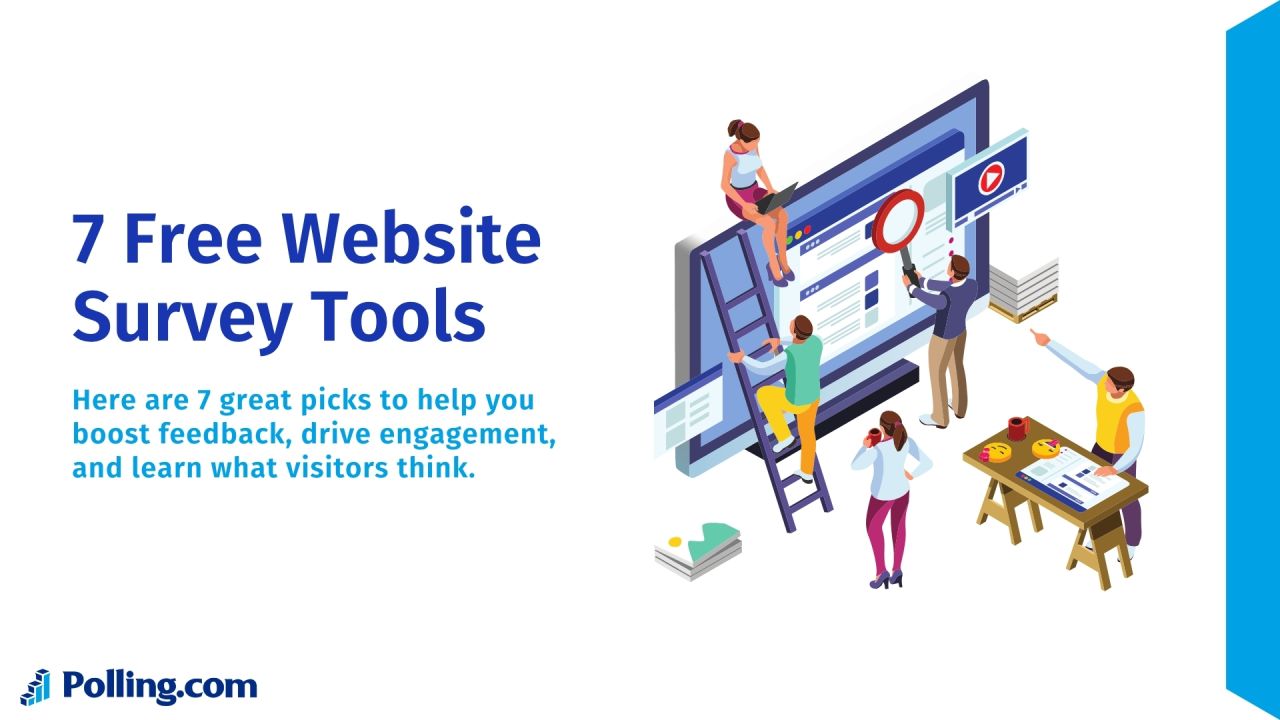
7 Free Website Survey Tools to Boost Engagement and Feedback
Collecting feedback directly from your website visitors has become crucial in today’s digital landscape.
Whether you’re testing new features, improving navigation, or just trying to understand what’s working, on-site surveys give you real-time insights that off-site forms simply can’t.
While Google Forms and similar tools are popular, they weren’t built for website interaction.
They lack features like behavior-based triggers, embedded targeting, and real-time analytics that today’s businesses need to improve user experience and drive engagement.
In this article, we’ll walk you through 7 free website survey tools designed specifically for on-site use.
These free online survey platforms offer more than just basic forms; they support advanced survey design, smarter survey methodology, and better ways to run everything from fun surveys to in-depth market research questions.
Why Free Website Survey Tools Are Essential
Website-based survey tools are built to capture real-time feedback while users are actively engaged with your content.
Unlike traditional forms that users fill out after the fact, these survey tools free let you connect with visitors at the perfect moment, right when they’re thinking, browsing, or even about to leave.
This approach has major benefits. You can identify what’s working (or not working), reduce bounce rates, and use that feedback to shape a smoother, more satisfying user journey.
Whether you’re a survey researcher, a solo creator, or part of a growing survey company, collecting in-the-moment feedback makes your survey analysis more actionable and relevant.
Another key difference lies in the survey methodology.
Many general free survey tools are great for distributing forms via email or social media, but they lack advanced features like behavior-based triggers, targeting options, or integrations with site analytics.
In contrast, website-specific survey tools are built with your website in mind, helping you run types of surveys that align with how visitors actually behave.
If you’ve ever thought about taking a survey while browsing a site, perhaps to give product feedback or rate a blog post, you’ve already experienced how powerful these free online survey tools can be.
The right tool can turn casual visitors into contributors and help you uncover the insights that matter most.
7 Free Website Survey Tools That Go Beyond Google Forms
If you’re still using Google Forms to collect feedback from your website visitors, you’re likely missing out on better data and more engaged users.
While it’s a great tool for simple questionnaires, it lacks the interactivity, customization, and real-time functionality needed for capturing feedback in the moment.
Here are the top 7 free website survey tools that can outperform Google Forms.
1. Polling.com – The Best Free Website Survey Tool for Real-Time Insights
Polling.com focuses entirely on helping you collect feedback while users are still on your site.
It offers everything from embedded survey widgets to popups and exit intent surveys. That means you can ask the right question at exactly the right time.
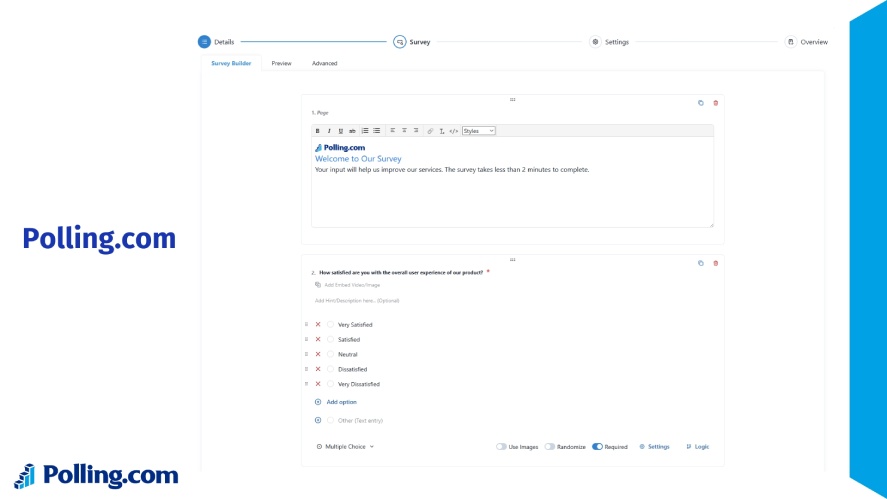
Built for web-specific use cases, Polling.com goes well beyond Google Forms with features like logic jumps, real-time analytics, and even A/B testing support.
Whether you’re gathering NPS data, checking customer satisfaction, or refining your UX, it provides deep, actionable insights for survey researchers and marketers alike.
The free plan includes core features that work great for smaller teams or test projects, with optional paid upgrades if you want to scale your feedback efforts.
2. Hotjar Surveys (Basic Plan)
Hotjar is known for its behavior-tracking tools, but its survey features are just as powerful.
The Basic Plan gives you access to NPS polls, quick feedback forms, heatmaps, and non-intrusive survey widgets that appear naturally on your website without interrupting the experience.

It’s especially useful for gathering contextual feedback, like asking visitors why they’re about to leave, or what could improve a specific product page.
While the free tier has some limits in terms of volume and survey complexity, it’s still an excellent starting point for those doing survey analysis or improving site experience on a budget.
3. Typeform for Web Embeds
Typeform stands out for its smooth, engaging approach to taking a survey. Instead of overwhelming users with long forms, it presents one question at a time in a sleek, chat-style interface.
This keeps people focused and often leads to higher response rates, especially for longer questionnaire templates or deeper market research questions.
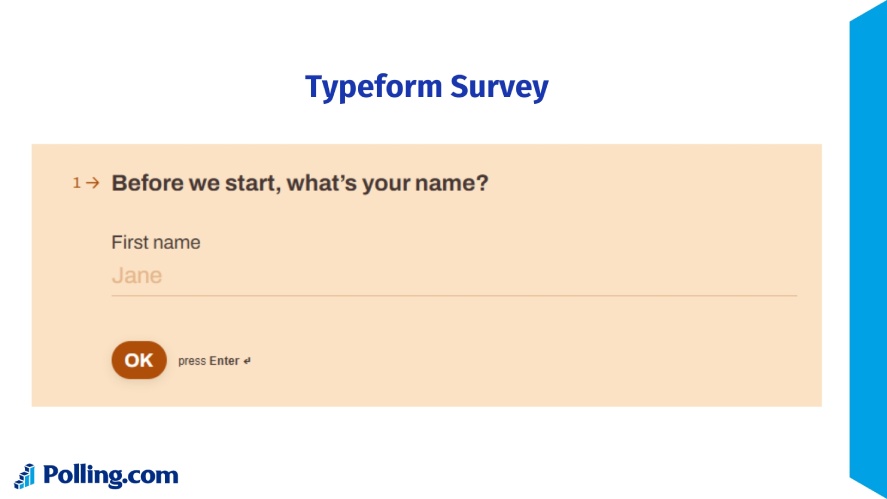
Its embed options are flexible: you can place surveys inline with your content, as popups, or even trigger them on specific actions.
If you’re looking to collect data while keeping the experience friendly, modern, and distraction-free, Typeform is one of the free website survey tools that’s hard to beat. The free plan covers basic functionality and integrates well into most websites.
4. Zoho Survey
Zoho Survey is a reliable choice if you’re already using Zoho products or want your website survey efforts to align with broader CRM and marketing tools.
It lets you embed surveys directly onto your pages, making it easy to collect real-time feedback without redirecting visitors.
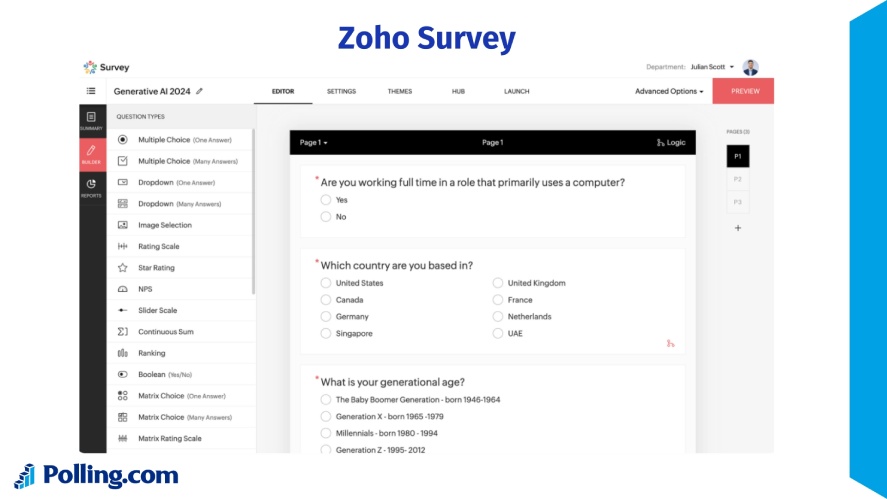
You’ll find handy features like conditional logic, multilingual support, and seamless integration with Zoho’s CRM.
It’s ideal for businesses looking to connect customer insights with actionable workflows. Even with the free plan, it offers enough flexibility for most survey design examples needs.
5. Jotform
Jotform is more than just a form builder; it’s a versatile platform that lets you create stylish, embed-ready surveys with ease.
Whether you’re adding a feedback widget or building a multi-step lead gen form, Jotform offers rich customization.
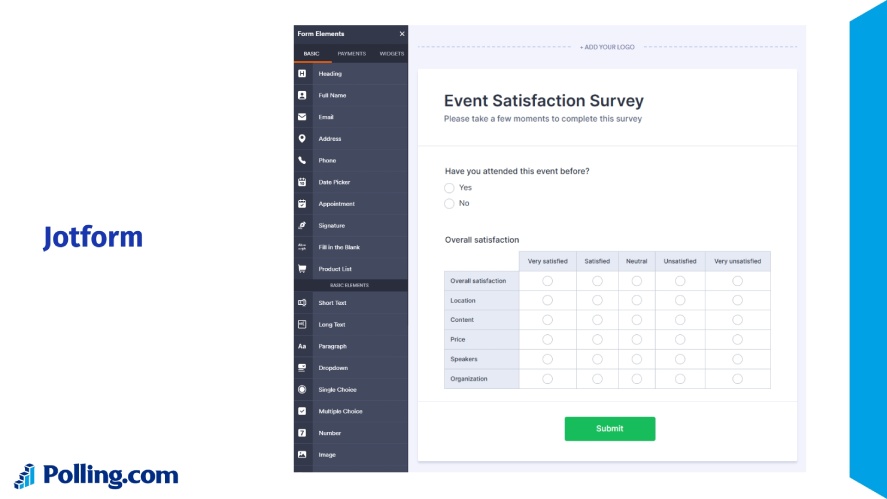
It supports payment collection, logic conditions, and even app-like widgets. Branding is easy to apply, and its free plan is surprisingly generous, with high limits on responses.
If you need a powerful and user-friendly tool that plays well with your site, Jotform is a strong contender.
6. SurveyPlanet
SurveyPlanet keeps things simple but stylish. It offers a clean, modern interface for building surveys and embedding them into websites without fuss.
Its intuitive editor is beginner-friendly, making it great for anyone starting out with survey research.

One standout feature of SurveyPlanet is the unlimited surveys and respondents on the free plan.
While advanced logic or exports may require an upgrade, the no-cost tier is more than enough for basic site feedback, educational projects, or community polls.
7. Crowdsignal
If your site runs on WordPress, Crowdsignal is tailor-made for you.
This tool makes it incredibly easy to embed polls, NPS surveys, and full questionnaires into blog posts, pages, or sidebars without extra user survey plugins.
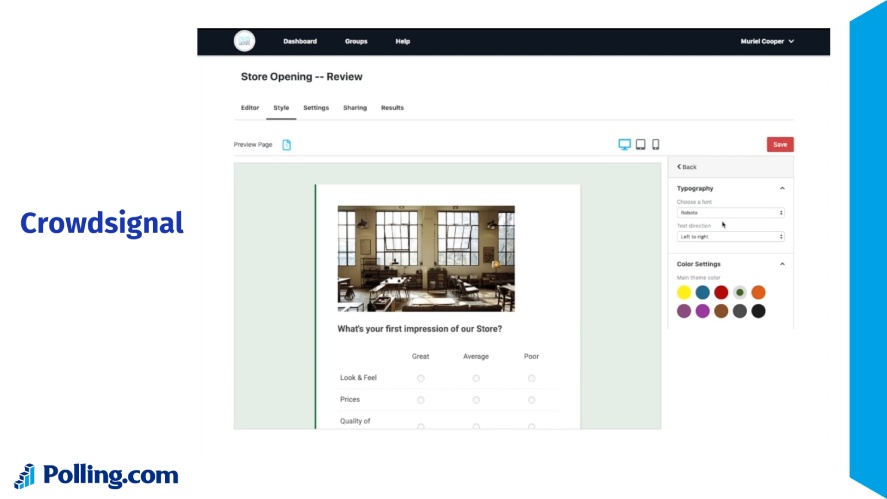
It’s ideal for content creators, educators, and small business owners who want to quickly gather audience opinions without diving into complex setup.
While its free plan has branding and some limitations, it’s a smooth way to start embedding surveys right into your site’s natural flow.
How to Choose the Right Free Website Survey Tool
With so many free website survey tools available, picking the right one for your website isn’t just about finding something free; it’s about finding the right fit for your goals.
Feature Checklist For Free Website Survey Tools
Start by evaluating each tool’s core features. Look for customization options that let you match your survey’s design to your brand.
Mobile responsiveness is a must, since users will be visiting your site from a range of devices. Next, integration with platforms like Google Sheets, CRMs, or marketing automation tools can help streamline your workflow.
Finally, solid analytics and reporting features ensure that the data you collect actually leads to useful insights.
Types of Surveys for Websites: Pop-Ups, Slide-Ins, Inline Forms, NPS Bars
Next, think about how the survey will appear on your site. Different formats serve different purposes.
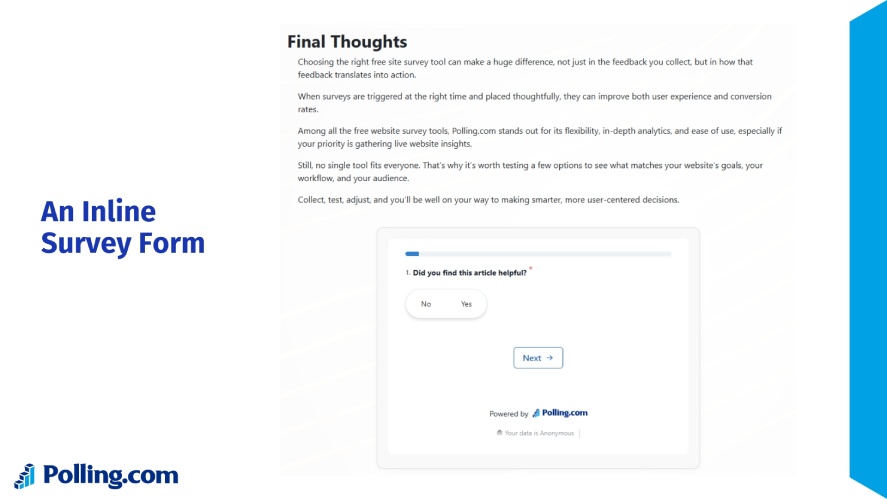
Pop-ups and slide-ins are great for grabbing attention, especially for exit surveys or limited-time promotions. Inline forms are ideal for more subtle feedback collection embedded within content or product pages.
NPS bars work well for quick sentiment checks without interrupting the user journey.
Decision-Making Tips Based on Use Case: UX Feedback vs. Lead Gen vs. Exit Surveys
Finally, align the tool to your survey’s specific purpose.
If you’re focused on improving the user experience, choose a tool that supports logic jumps, A/B testing, and quick polls that don’t slow down the site.
For lead generation, opt for tools with strong embed options and integration with email marketing platforms.
And for exit-intent surveys, look for tools that trigger forms based on user behavior, giving you one last chance to capture feedback before they leave.
Final Thoughts
Choosing the right free site survey tool can make a huge difference, not just in the feedback you collect, but in how that feedback translates into action.
When surveys are triggered at the right time and placed thoughtfully, they can improve both user experience and conversion rates.
Among all the free website survey tools, Polling.com stands out for its flexibility, in-depth analytics, and ease of use, especially if your priority is gathering live website insights.
Still, no single tool fits everyone. That’s why it’s worth testing a few options to see what matches your website’s goals, your workflow, and your audience.
Collect, test, adjust, and you’ll be well on your way to making smarter, more user-centered decisions.
